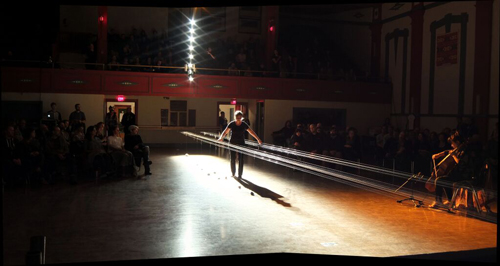by Mike Telin

The concerts represent more than 30 years of work-in-progress for Fullman, who over time has created her own unique sound world. In the spirit of music expressing what words cannot, click here to listen to examples of the haunting sounds of an instrument described as “an installation of dozens of wires 50 feet or longer tuned in just intonation and ‘bowed’ with rosin-coated fingers.”
“‘Foghorns’ is a one-hour work in five movements which Theresa and I approached by taking the cello out of the traditional classical style and thinking of it as a resonating body,” Fullman said during a telephone conversation. “The piece is generated from a series of harmonics produced by the cello, although we are not sticking to the standard harmonics that are common in classical repertoire. Theresa will also use software that allows her to add layers of sound.” Fullman added that she and Wong are taking musical cues from the works of bassist Mark Dresser and the sounds produced by the Chinese “philosophers’ instrument” the guqin. She also pointed out that because the work is based on improvisation, it is slightly different every time.
Since the creation of the instrument Fullman has had to overcome certain technical hurdles to make the instrument more functional. “In the beginning I was amazed by the sound the instrument produced, but I could not tune it. I thought that if I could do that, I could play chords.”
Fullman also had to figure out how to change the lengths of the strings. “Today I use custom-designed clips, but at the beginning I worked with off-the-shelf C-clamps to stop the strings from vibrating. The problem was that the C-clamps needed to weigh two to two and a half ounces to stop the wave, because if it was smaller, a portion would continue to vibrate. Once I got it tuned, the instrument began to produce a wonderful ethereal quality which hooked me.”
In the beginning Fullman said that she imagined the instrument being akin to a theremin, where a simple gesture could create a shape and form. Today she is able to sculpt harmonic forms as she moves along the length of the string. “That is what hooked me for all these years: training myself, as well as keeping the instrument evolving, from my performance technique to what kind of wire I should use to designing the clips. All of these things factor into the sound that is produced and I’ve been working all of these years to achieve a smoother and richer timbre.”
Another challenge Fullman had to address was how to notate music for the instrument, a process that evolved. Because she walks from place to place while playing, she had to create a tablature that choreographs her movements along the lengths of the strings.
Having installed the instrument all over the world, strange locations have been an added bonus to Fullman’s work. “I get to explore the acoustics of all kinds of places all over the world, and that has really been fun. One strange but cool place was in Austin, Texas, where I worked in a decommissioned power plant that was fantastic. I love being able to go into places that are closed off to the public, and I love resonant spaces. They always make me think of the early music that was composed for cathedrals where the sounds hang in the air and new sounds enter and blend into them.”
In an article published in Musicworks in 2003, Fullman discusses the evolution of the Long String Instrument.
Published on ClevelandClassical.com September 22, 2015.
Click here for a printable copy of this article



